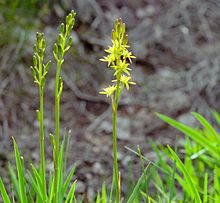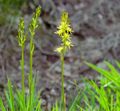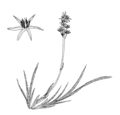- Narthecium ossifragum
-
Narthecium ossifragum 
Scientific classification Kingdom: Plantae (unranked): Angiosperms (unranked): Monocots Order: Dioscoreales Family: Nartheciaceae Genus: Narthecium Species: N. ossifragum Binomial name Narthecium ossifragum
(L.) Huds.Narthecium ossifragum, commonly known as bog-, Lancashire- or bastard asphodel, is a plant of Western Europe, found on wet, boggy moorlands up to about 1000 m. It produces spikes of bright yellow flowers in summer. The bright orange fruits have been used as a colourant to replace saffron by Shetland Islanders[1]. Despite the plant's English name, it is not particularly closely related to the true Asphodels.
The Latin name means "weak bone" and refers to a traditional belief that eating the plant caused sheep to develop brittle bones. The probable origin of this story is that sheep eating a calcium poor diet are likely to develop bone weakness, and N. ossifragum favours acidic, low calcium soils[1]
The plant causes a disease of sheep called alveld, "elf fire", in Norway. Not all stands of the plant are toxic, and the toxicity may be the side effect of the plant's response to a fungal infection [2][3][4]
It can be found in purple moor grass and rush pastures.
Gallery
Illustrations
References
Categories:- Dioscoreales
- Monocot stubs
Wikimedia Foundation. 2010.








